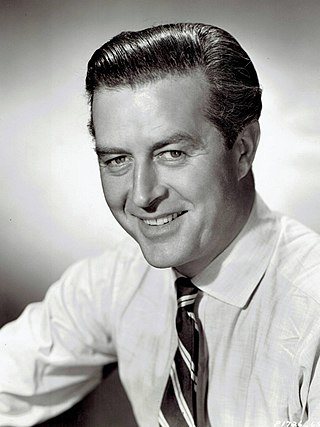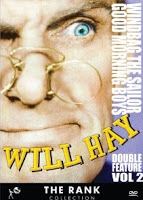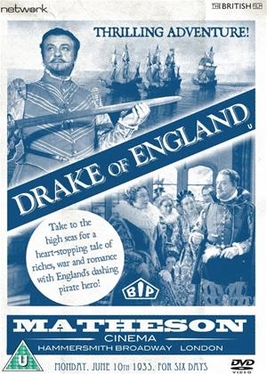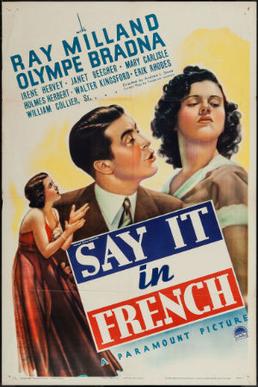
Ray Milland was a Welsh-American actor and film director. He is often remembered for his portrayal of an alcoholic writer in Billy Wilder's The Lost Weekend (1945), which won him Best Actor at Cannes, a Golden Globe Award, and ultimately an Academy Award—the first such accolades for any Welsh actor.

Goodwin Sands is a 10-mile-long (16 km) sandbank at the southern end of the North Sea lying 6 miles (10 km) off the Deal coast in Kent, England. The area consists of a layer of approximately 25 m (82 ft) depth of fine sand resting on an Upper Chalk platform belonging to the same geological feature that incorporates the White Cliffs of Dover. The banks lie between 0.5 m above the low water mark to around 3 m (10 ft) below low water, except for one channel that drops to around 20 m (66 ft) below. Tides and currents are constantly shifting the shoals.
George Thomas Moore Marriott was an English character actor best remembered for the series of films he made with Will Hay. His first appearance with Hay was in the film Dandy Dick (1935), but he was a significant supporting performer in Hay's films from 1936 to 1940, and while he starred with Hay during this period he played a character called "Harbottle" that was based on a character Marriott usually played. His character Harbottle was originally created by Hay when he used the character in his "The fourth form at St. Michael's" sketches in the 1920s.

Good Morning, Boys! is a 1937 British comedy film directed by Marcel Varnel and featuring Will Hay, Graham Moffatt, Martita Hunt, Lilli Palmer and Peter Gawthorne. It was made at the Gainsborough Studios in Islington.

Juggernaut is a 1936 British mystery film, starring Boris Karloff and Joan Wyndham. Directed by Henry Edwards, it was based on the novel by Alice Campbell and was distributed by Julius Hagen Productions. It was also known as The Demon Doctor.
This is a filmography of Welsh actor Ray Milland, containing his work in theatrically released motion pictures as well as his extensive television credits. Milland began his film career in United Kingdom in 1929 after serving three years as a guardsman in the Royal Household Cavalry, based in London. After appearing in several British films, he went to the United States in 1930 where he spent several years playing small and supporting roles. Eventually, in 1934, he became a contract player at Paramount Pictures where he established himself as a popular star. Milland remained with Paramount for the next 21 years. During his time with the studio, he developed his persona as a debonair leading man, mainly in drawing-room comedies but also occasionally in adventure and mystery films. In 1945, Milland won the Academy Award for Best Actor for his portrayal of an alcoholic writer in The Lost Weekend. From there he continued as a leading man well into the 1960s, appearing in several film noirs and occasionally cast as a villain. In 1953, Milland began working in television as both an actor and director. He alternated between the mediums of film and television for the remainder of his career. During the 1960s and 1970s, Milland frequently worked in science fiction and horror films. He also directed himself in four films.
Dance Pretty Lady is a 1931 British drama film directed by Anthony Asquith and starring Ann Casson, Carl Harbord, Michael Hogan, Moore Marriott and Flora Robson. It was based on the 1912 novel Carnival by Compton Mackenzie. The novel was subsequently remade as a 1946 film Carnival.

Drake of England is a 1935 British drama film directed by Arthur B. Woods and starring Matheson Lang, Athene Seyler and Jane Baxter. It depicts the life of Francis Drake and the events leading up to the defeat of the Armada in 1588.

The Big Game is a 1973 action film directed by Robert Day and starring Stephen Boyd, France Nuyen and Ray Milland. It was shot on location in Cape Town, Rome and Hong Kong. It is also known by the alternative title of Control Factor.

The Informer is a 1929 British sound part-talkie drama film directed by Arthur Robison and starring Lya De Putti, Lars Hanson, Warwick Ward and Carl Harbord. The picture was based on the 1925 novel The Informer by Liam O'Flaherty. In the film, a man betrays his best friend, a member of the outlawed Irish Republican Army, to the authorities and is then pursued by the other members of the organisation. The later better-known adaptation The Informer (1935) was directed by John Ford.

The Flying Scotsman is a 1929 British black and white part-talkie film set on the Flying Scotsman train from London to Edinburgh, also featuring the famous locomotive LNER Class A3 4472 Flying Scotsman. In addition to sequences with audible dialogue or talking sequences, the film features a synchronized musical score and sound effects along with English intertitles. Directed by Castleton Knight, the thriller is chiefly remembered for being the first acting role of Ray Milland, as well as for its daring stunts performed aboard the moving train.

Mona Goya was a Mexican-born French film actress who rose to fame in the 1930s.

Kitty is a 1929 sound part-talkie British drama film directed by Victor Saville and starring Estelle Brody and John Stuart. In addition to sequences with audible dialogue or talking sequences, the film features a synchronized musical score and sound effects along with English intertitles. The film was adapted from the 1927 novel of the same name by Warwick Deeping and marked the third co-star billing of Brody and Stuart, who had previously proved a very popular screen pairing in Mademoiselle from Armentieres (1926) and Hindle Wakes (1927).

Sealed Verdict is a 1948 American mystery drama war film directed by Lewis Allen and starring Ray Milland, Florence Marly and starring Broderick Crawford. The film was based on the novel The Sealed Verdict by Lionel Shapiro. It was produced and distributed by Paramount Pictures. Extensive location shooting took place in Strasbourg, which had been occupied by the Germans from 1940 to 1944.
The Plaything is a 1929 British part-talkie sound romance film directed by Castleton Knight and starring Estelle Brody, Heather Thatcher and Nigel Barrie. The film was a mixture of silent and sound film as it was released during the transition period following Blackmail. It was based on the play Life Is Pretty Much the Same by Arthur Jarvis Black. It was made by British International Pictures at Elstree Studios.
Clothes and the Woman is a 1937 British romance film directed by Albert de Courville and starring Rod La Rocque, Tucker McGuire and Constance Collier. It was made at Elstree Studios in Hertfordshire.
Jenny Lind is a 1932 American pre-Code musical film directed by Arthur Robison and starring Grace Moore, André Luguet and André Berley. It is a French-language remake of the 1930 film A Lady's Morals, which also starred Moore but had a largely different cast and crew. Alternative language versions were common during the early years of sound until dubbing became more widespread.

Say It in French is a 1938 American comedy film directed by Andrew L. Stone and written by Frederick J. Jackson. The film stars Ray Milland, Olympe Bradna, Irene Hervey, Janet Beecher, Mary Carlisle and Holmes Herbert. The film was released on November 28, 1938, by Paramount Pictures.
Faces is a 1934 British drama film directed by Sidney Morgan and starring Anna Lee, Harold French and Walter Sondes.

Menace is a 1934 American mystery film directed by Ralph Murphy and starring Gertrude Michael, Paul Cavanagh and Henrietta Crosman. The emerging star Ray Milland billed fifth. It was produced and distributed by Paramount Pictures. It is based on the 1933 novel Menace by British writer Philip MacDonald. Mitchell Leisen was originally intended to direct the film before being replaced by Murphy. A review in the New York Times considered "it ranks several notches higher than the average murder film".













